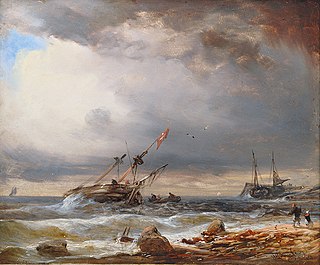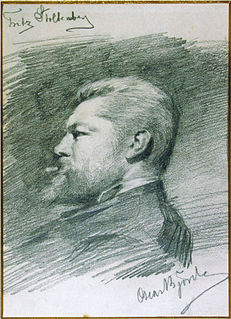 W
WAndreas Achenbach was a German landscape and seascape painter in the Romantic style. He is considered to be one of the founders of the Düsseldorf School. His brother, Oswald, was also a well known landscape painter. Together, based on their initials, they were known as the "Alpha and Omega" of landscape painters.
 W
WHans Bohrdt was a German artist. He was a self-taught painter who would later go on to give private lessons to Kaiser Wilhelm II. German Kaiser Wilhelm II took a liking to Bohrdt and would fund all of his projects, which were often nationalistic in nature. In 1915 Bohrdt created his most famous illustration which is called "The Last Man". The image shows a German navy sailor holding up a German flag as his ship sinks during the Battle of the Falkland Islands because he would rather go down with the ship than surrender. "The Last Man" would become one of the most widely recognized propaganda images used during the war to inspire courage. Bohrdt was accepted into the Imperial Yacht Club in Kiel. In 1906 the Kaiser granted Bohrdt a spacious villa in Berlin. After World War I, Bohrdt made a living drawing maritime postcards, book illustrations, magazines, and supplied images for newspaper articles.
 W
WHermann Wilhelm Benjamin Eschke was a German painter who specialized in marine art.
 W
WJohn Gleich was a Baltic-German merchant, painter and publicist; best known for Oriental and maritime scenes.
 W
WWilhelm August Leopold Christian Krause was a German landscape and marine painter.
 W
WMichael Zeno Diemer was a German painter. Now known primarily for his marine paintings and postcard designs, he was initially famous for his panoramic paintings of battles.
 W
WFriedrich Preller was a German land and seascape painter.
 W
WCarl Wilhelm Hugo Schnars-Alquist was a German art collector and painter of maritime scenes.
 W
WFriedrich Wilhelm Schulz, alias Fritz W. Schulz, was a German marine artist and illustrator of the 20th century.
 W
WJulius Stockfleth was a German-born painter of landscapes and marine subjects. His images of the city of Galveston, Texas, constitute a valuable record of the town between 1885 and 1907, especially its devastation by the hurricane of 1900.
 W
WFritz Stoltenberg was a German landscape and marine painter. After a summer with the Skagen Painters in 1884, he returned to Kiel where he painted and sketched the old town and the harbor, publishing many of his illustrations in local magazines.
 W
WWilly Stöwer was a German artist, illustrator and author during the Imperial Period. He is best known for nautical paintings and lithographs. Many of his works depict historical maritime events such as the sinking of the RMS Titanic in 1912.
 W
WAdolph Friedrich Vollmer was a German landscape and marine painter and graphic artist. He and his contemporary, the painter Christian Morgenstern, were pioneers in Hamburg of early Realism in painting.